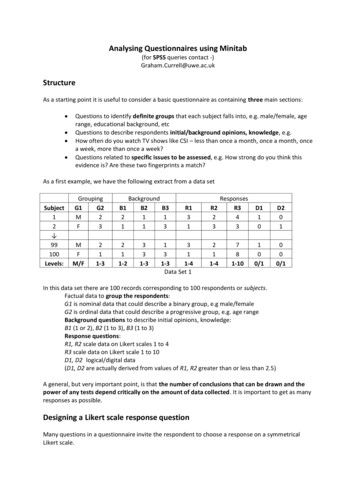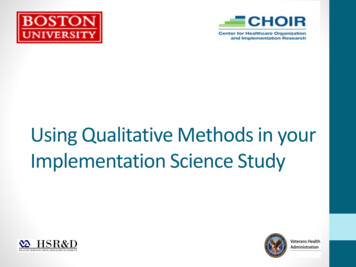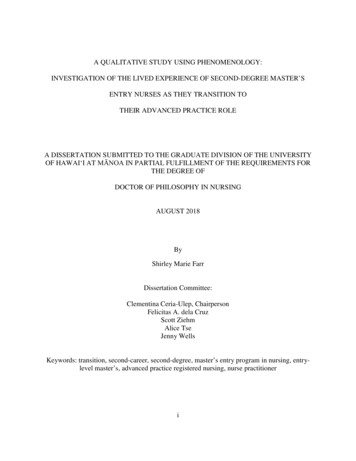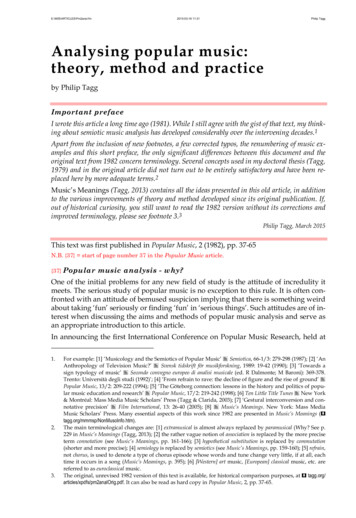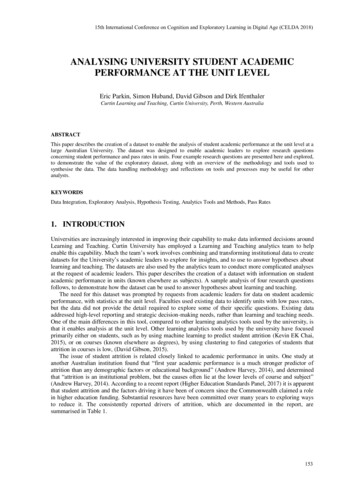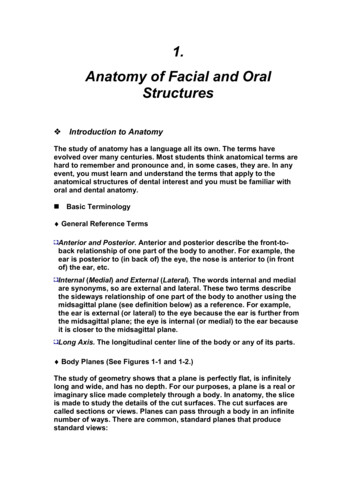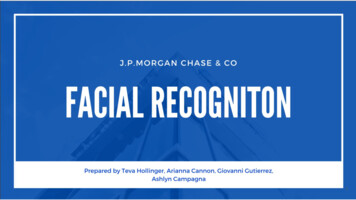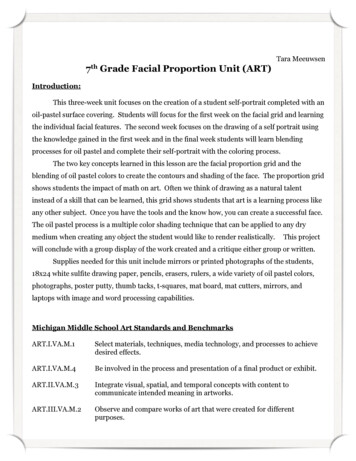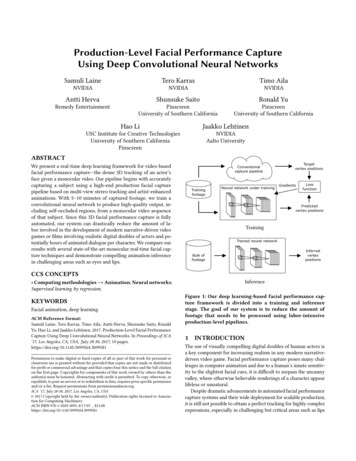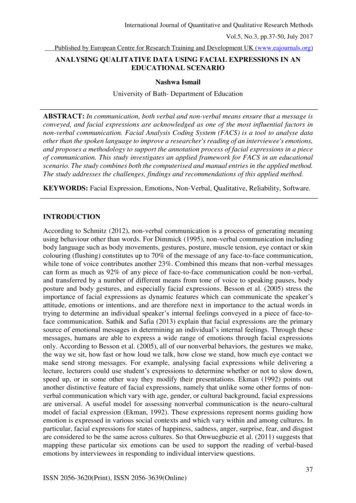
Transcription
International Journal of Quantitative and Qualitative Research MethodsVol.5, No.3, pp.37-50, July 2017Published by European Centre for Research Training and Development UK (www.eajournals.org)ANALYSING QUALITATIVE DATA USING FACIAL EXPRESSIONS IN ANEDUCATIONAL SCENARIONashwa IsmailUniversity of Bath- Department of EducationABSTRACT: In communication, both verbal and non-verbal means ensure that a message isconveyed, and facial expressions are acknowledged as one of the most influential factors innon-verbal communication. Facial Analysis Coding System (FACS) is a tool to analyse dataother than the spoken language to improve a researcher's reading of an interviewee's emotions,and proposes a methodology to support the annotation process of facial expressions in a pieceof communication. This study investigates an applied framework for FACS in an educationalscenario. The study combines both the computerised and manual entries in the applied method.The study addresses the challenges, findings and recommendations of this applied method.KEYWORDS: Facial Expression, Emotions, Non-Verbal, Qualitative, Reliability, Software.INTRODUCTIONAccording to Schmitz (2012), non-verbal communication is a process of generating meaningusing behaviour other than words. For Dimmick (1995), non-verbal communication includingbody language such as body movements, gestures, posture, muscle tension, eye contact or skincolouring (flushing) constitutes up to 70% of the message of any face-to-face communication,while tone of voice contributes another 23%. Combined this means that non-verbal messagescan form as much as 92% of any piece of face-to-face communication could be non-verbal,and transferred by a number of different means from tone of voice to speaking pauses, bodyposture and body gestures, and especially facial expressions. Besson et al. (2005) stress theimportance of facial expressions as dynamic features which can communicate the speaker’sattitude, emotions or intentions, and are therefore next in importance to the actual words intrying to determine an individual speaker’s internal feelings conveyed in a piece of face-toface communication. Sathik and Safia (2013) explain that facial expressions are the primarysource of emotional messages in determining an individual’s internal feelings. Through thesemessages, humans are able to express a wide range of emotions through facial expressionsonly. According to Besson et al. (2005), all of our nonverbal behaviors, the gestures we make,the way we sit, how fast or how loud we talk, how close we stand, how much eye contact wemake send strong messages. For example, analysing facial expressions while delivering alecture, lecturers could use student’s expressions to determine whether or not to slow down,speed up, or in some other way they modify their presentations. Ekman (1992) points outanother distinctive feature of facial expressions, namely that unlike some other forms of nonverbal communication which vary with age, gender, or cultural background, facial expressionsare universal. A useful model for assessing nonverbal communication is the neuro-culturalmodel of facial expression (Ekman, 1992). These expressions represent norms guiding howemotion is expressed in various social contexts and which vary within and among cultures. Inparticular, facial expressions for states of happiness, sadness, anger, surprise, fear, and disgustare considered to be the same across cultures. So that Onwuegbuzie et al. (2011) suggests thatmapping these particular six emotions can be used to support the reading of verbal-basedemotions by interviewees in responding to individual interview questions.37ISSN 2056-3620(Print), ISSN 2056-3639(Online)
International Journal of Quantitative and Qualitative Research MethodsVol.5, No.3, pp.37-50, July 2017Published by European Centre for Research Training and Development UK (www.eajournals.org)The structure of this paper is as follows. First, it reviews the current situation of FACS. Thisreview places more focus on FACS in education as it is the area of the researcher’s expertiseand on which the empirical data is collected. Also, a highlight of FACS in qualitative research,is addressed. This is followed by the applied methodology and its detailed steps. The nextsection is discussion of the applied method, discoveries and challenges within this method.Final section is the conclusion and future research.LITERATURE/THEORETICAL UNDERPINNINGCurrency of FACSOnwuegbuzie et al. (2011) conclude that research to date neither presents a clear model of howto interpret this nonverbal communication, nor gives guidelines for researchers on how to useit to help answer their research questions. This claim is confirmed by Valstar et al. (2015),explaining that despite efforts towards evaluation standards in facial expression analysis(FERA 2011, The First Facial Expression Recognition and Analysis Challenge’, Conference,Santa Barbara, California, March 2011), there is a need for up-to-date standardised evaluationprocedures, focusing in particular on current challenges in the field. One of the challenges thatthere is a call to continue providing a standardisation platform and to help the field progressbeyond its current limitations. The Facial Expressions Recognition Analysis (FERA) (Valstaret al, 2017) extended to focus on expression analysis under different camera views, theygenerate an extensive set of videos comprising 9 different views. They addressed that need tomore research to conclude to robust detection under non-frontal head poses and intensityestimation. From my view, it seems that a number of the steps that are still completed manuallyto date, could easily become computer–based, such as an automatic calculation of the durationand frequency values inserted in the sheet by the researcher, resulting in a digital form readyfor analysis or printing. In this study, an investigation of this computed calculation is addressed.FACS in EducationIn education, FACS can help to obtain a database of emotional data in an educational context.The following section explains different studies where FACS could guide in formingimpression about students' understanding of lectures, keeping the students motivated andinterested during lectures. Also, in identifying changes in the learners’ states when dealing withMathematics problems. A study by Sathik and Sofia (2013) concentrates on the use of facialexpressions in communication in the context of education. The goal of their study is to identifyphysical behaviours of the face that are linked to emotional states, and then to identify howthese emotional states are linked to student’s comprehension, particularly on the way teachersand students use facial expressions to form impressions of each other. The study statisticallyproved that facial expressions of the students are the most used nonverbal communication modein the classroom and student’s expressions are significantly correlated to their emotions whichcan help to recognise their comprehension towards the lecture. Similarly, Bosson et al. (2004)stress how understanding facial expressions can help teachers to keep the students motivatedand interested for example during lectures, so that a teacher's understanding of their students’facial expressions and thus their emotions can be used as a source of feedback by the teacherto analyse the impact of their lecture and identify areas of improvement. Saneiro et al. (2014)use FACS to detect emotions in students’ interactions while solving mathematics problems,and analyse how the participants’ emotional reactions in this learning scenario are influenced38ISSN 2056-3620(Print), ISSN 2056-3639(Online)
International Journal of Quantitative and Qualitative Research MethodsVol.5, No.3, pp.37-50, July 2017Published by European Centre for Research Training and Development UK (www.eajournals.org)by the duration of the task and its difficulty level, and how the valence and arousal levelsinfluence emotions reported by the students themselves. Their analysis makes clear how allthese factors have an impact on the students' emotions which can be observed through the facialexpressions and body movements during learning tasks that involve cognitive processes, suchas mathematics and physics. The significance of using FACS in this study that it could identifychanges in the learners’ affective states when dealing with cognitive tasks which help toprovide emotional personalised support by tutor. In summary, using FACS in the previousstudies can inform teachers to change their applied teaching tactics or strategies for a betterstudents’ understanding or class engagement. In summary, these studies produces somecontributions to support the analysis of facial expressions that considers information about thecognitive process which is very relevant in an educational scenario.FACS as a research methodology in qualitative data analysisOnwuegbuzie et al. (2009) emphasize that in the analysis of participants' responses in anyinterview context, interpreting only the text can be problematic, since the words alone may notprovide in-depth information for example about the degree of agreement or disagreementbetween participants in a focus group discussion. Driscoll et al. (2007) similarly stress thatresearchers need to think of the social processes that keep research honest and enhance itsfairness, and Norris (1997) identifies the problem of qualitative research as the difficulty ofconstructing rules for judging the validity of particular studies, and of specifying procedureswhich if followed will systematically eliminate bias and error. These observations highlightthe need to minimise bias in qualitative research by using analytical methods that are able toquantify qualitative data to separate data analysis from the researcher themselves, and to movetowards an increased use of technology.Mehrabina (1971) arguing that only 7% of the expression of the individual's thought is madewith words and the remaining 93% is made with gestures, body movements, voice intonation,speed of pronunciation etc. According to Hoque et al. (2017) FACS has proven beneficial inboth confirming the qualitative findings and identifying emotional reactions, both positive andnegative. In detail, linking between verbal data (i.e. interviews) and non-verbal data (i.e. facialexpressions) help in assembling the meaning and relevance of what has been said.Consequentially, according to Ana Maria Sadalla and Priscilla Larocca (2004), the videorecording is suitable to capture aspects that may go unnoticed when other resources are used.Such aspects such as: body, facial and verbal language. For them, "video recording allowsrecording momentary and non-repeatable events, which are very likely to escape directobservation" (p. 423). In combination with video recordings, a computer-based FACS analysiscan separate facial expressions into distinctively measurable units, providing a tangibleapproach to investigating the causes and effects of facial expressions (Ekman, 2006).METHODOLOGYVideo recordings, computer-based FACS anaylsis software and extraction sheets are themethods used sequentially in this study. Firstly, the qualitative data used in this paper wascollected during research on teachers’ perceptions of student-centred learning in the onlineenvironment, and consists of a video recording of a piece of verbal communication with arespondent in a one-to-one interview, in which an online tutor speaks about a situation wherehis students ask him a question to which he does not know the answer. Secondly, capturing this39ISSN 2056-3620(Print), ISSN 2056-3639(Online)
International Journal of Quantitative and Qualitative Research MethodsVol.5, No.3, pp.37-50, July 2017Published by European Centre for Research Training and Development UK (www.eajournals.org)video recording of the tutor into facial expression analysis computer programme. Example ofthese programmes are such as: Noldus (Noldus, 2017) and the used software in this study is:Sightcorp (Sightcorp, 2017). These programmes capture, interpret emotions as they occur andmake direct measurement of emotional response. Within this phase using the program, FACSinvolves three stages: (1) face acquisition (finding the face region for the input images), (2)facial data extraction (representing the facial changes caused by facial expressions,representation), and (3) facial expression recognition (identifying facial changes as emotionalexpressions) (Tan et al, 2011). For (1) and (2), Software (Sightcorp) analysed human emotionsfrom facial expression was used for acquisition as well as data extraction and representation.For (3), according to FERA (2015), most FACS proposed in the literature focus on the binaryoccurrence of expressions, often either basic emotions or FACS Action Units (AUs) which arethe observable component of facial movement. In reality, expressions can vary greatly inintensity, and this intensity is often a strong cue for the interpretation of the meaning ofexpressions. Therefore, step (3) will start by using the software where facial expression isrecognized and will be continued by Kring and Sloan's (2007) Face Coding Sheets (FCS),which record four factors: (1) Expression (the result of (1) face acquisition and (2) facial dataextraction), (2) Frequency, (3) Valence (positive or negative feeling), and (4) Intensity (low medium - high - very high rating). Following their methodology, frequency and duration ofexpressions were totaled and recorded.The objective of integrating FACS results between the program and the extracting sheets is toincrease the reliability of the program’s results by focusing on variables (i.e. frequency, valenceand intensity). This integration ends up with the overall feeling of the confronted situation (fulldetails of these variables are explained later in this study).The use of FACS in this study focuses on the analysis of only six facial expressions whichcorrespond
ANALYSING QUALITATIVE DATA USING FACIAL EXPRESSIONS IN AN EDUCATIONAL SCENARIO Nashwa Ismail University of Bath- Department of Education ABSTRACT: In communication, both verbal and non-verbal means ensure that a message is conveyed, and facial expressions are acknowledged as one of the most influential factors in non-verbal communication. Facial Analysis
